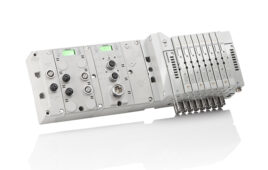 Many pharmaceutical companies have recently ramped up their focus on digital transformation. But in the highly regulated pharma industry, digital transformation programs can be slow and expensive.
Many pharmaceutical companies have recently ramped up their focus on digital transformation. But in the highly regulated pharma industry, digital transformation programs can be slow and expensive.
Hyderabad, India–based AmpleLogic works with pharma companies to launch and scale digital transformation initiatives via its low-code platform, which can standardize and accelerate innovation in the industry, according to Manne Venkanna Chowdary, CEO of the company.
Many large Big Pharma companies are “marching toward digitalization and digitally transforming their business,” Chowdary said. Conversely, a significant portion of small- to medium-sized companies is still deploying automation technology.
The digital transformation process is gradual. “Once you have automation in place, you don’t jump into digital transformation,” Chowdary said. “You try to create a bridge between your automation and digital transformation by trying to implement business process excellence solutions.”
Pharma companies with automation technology can electronically capture data that software can help analyze. “You try to apply intelligence to the data to improve productivity and efficiency,” Chowdary said. The first aim is not to completely transform the business. Instead, it is to improve productivity with software. “You are working to have more effective utilization of resources,” he added.
The resulting benefits and savings enable pharma companies to begin planning the next stage of digital transformation. “Our customers have had a good amount of improvement in the quality control, production area and compliance,” Chowdary said.
The digital transformation process, however, requires considerable exploration and careful planning. “Full-scale adoption of digital technologies takes a long time because there are many scenarios to consider,” Chowdary noted.
In the following interview, Chowdary reveals how he got involved in the pharma industry and how AmpleLogic can help life science companies accelerate digital transformation.
The responses have been lightly edited.
Please summarize your background.
Chowdary: I have about 22 years of experience in the IT industry. I started my career as a software developer and business analyst in the banking services industry.
After traveling across the globe for work, I realized the importance of doing something different. So I created a company to reduce the turnaround time involved in launching applications by developing a rapid application development platform. Today, the industry calls it a ‘low-code’ platform.
What inspired you to move from the financial sector to the pharmaceutical industry?
Chowdary: Having worked in the wealth management industry, I asked myself, ‘Why can’t I step into the health industry?’

Manne Venkanna Chowdary
I connected with some pharma CDMOs and CMOs in India and contemplated automating some of their processes using a low-code platform. I got very good acceptance. Our first installation was in 2012. From there onwards, we kept on adding more and more products. Today we have about 18 ready-to-use software solutions, which we call Commercial-off-the-Shelf Software (COTS) products. We have around 100 customers.
Our unique value proposition is the quick turnaround to deploy our technologies.
There are currently about 250 people working for the company. We are continuously working to keep upgrading our solutions with the latest technologies with things like microservices, cloud enablement and Docker container methodologies. We always need to upgrade ourselves technologically to optimize productivity. AmpleLogic continuously upgrades its solutions so we can deliver value to our customers and so customers can have the latest technology and comply with the most current cybersecurity standards.
Where are your customers based primarily?
Chowdary: We have a very good presence in India and the Middle East. We have seen increased traction in Egypt because the CDMOs and CMOS there are adopting global regulatory standards.
We are getting traction in the U.S. and Europe.
AmpleLogic says it can deploy software up to 10 times faster with fewer resources than traditional software deployments. How?
Chowdary: Across the industry, there are shared software requirements. A low-code software considers all these common points in a development platform, so we don’t need to write code for these things repeatedly. Instead, we can consider what the standard requirements are.
We have created all this functionality that is ready to use with open components. We can use a drag-and-drop methodology for most solution requirements. We can develop an application with a creative business process flow. It is similar to creating a flowchart in software like Microsoft Visio. You can create a flowchart even in a Word document. This low-code approach gives you flexibility, so you don’t need to write code for everything.
When a new customer comes along, we can start creating this application with a drag-and-drop methodology. So the customer can visually see that the solution will work. And the customer can add inputs on top of it. So it is more of a collaboration that helps us make application development faster.
Our software engineers are sitting in our office where we’re creating this entire platform, but our business analyst goes to the customer to create a drag-and-drop–based application for them.
The software engineer’s job is to focus on R&D and innovation. They can add new features and technologies to the low-code platform. Today, a low-code platform includes analytics as well as the application. You can automate many tasks using a low-code approach.
Some of our customers recruit software engineers to manage the applications. As a result of the talent crunch in the manufacturing sector, business analysts are taking over part of software engineers’ job. One large customer recruited eight business analysts to help create an application on our low-code platform.
As the pharma sector consolidates, how does that affect digital transformation plans?
Chowdary: Let me give a classic example. One of the largest M&A deals in the Indian pharma industry was the merger of Ranbaxy and Sun Pharma. Merging is not that easy because each company has its own processes.
We have worked to use our low-code platform to bridge the gap between merging companies so that their business continuity is not affected. Another aim is to facilitate tech transfer so that the process is easy for them.
Some customers are focused on predictive maintenance of equipment. For example, if a pharmaceutical company’s autoclave machine fails, it could lose millions of dollars because its entire product would be wasted. With IoT devices, you can do predictive maintenance to determine the likelihood that the autoclave device could fail.
Many anomalies can occur on the shop floor. Each anomaly could cost roughly $500,000 to $2 million.
Digital technology can help pharma companies monitor whenever such a deviation occurs and help them avoid those kinds of deviation. In addition, data can help them better understand the parameters that may trigger a deviation before it happens.





Tell Us What You Think!